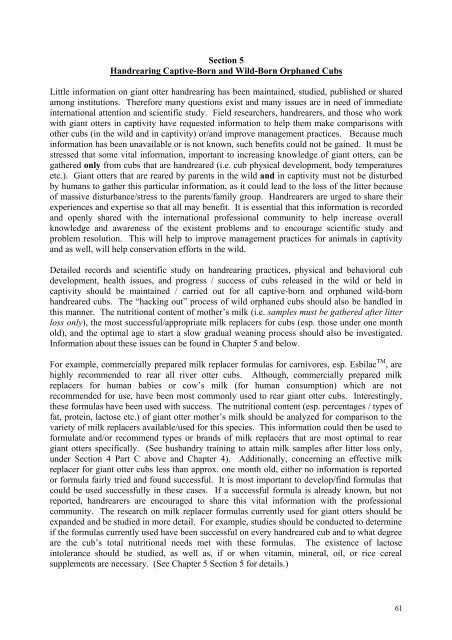International Giant Otter Studbook Husbandry and Management
International Giant Otter Studbook Husbandry and Management
International Giant Otter Studbook Husbandry and Management
You also want an ePaper? Increase the reach of your titles
YUMPU automatically turns print PDFs into web optimized ePapers that Google loves.
Section 5<br />
H<strong>and</strong>rearing Captive-Born <strong>and</strong> Wild-Born Orphaned Cubs<br />
Little information on giant otter h<strong>and</strong>rearing has been maintained, studied, published or shared<br />
among institutions. Therefore many questions exist <strong>and</strong> many issues are in need of immediate<br />
international attention <strong>and</strong> scientific study. Field researchers, h<strong>and</strong>rearers, <strong>and</strong> those who work<br />
with giant otters in captivity have requested information to help them make comparisons with<br />
other cubs (in the wild <strong>and</strong> in captivity) or/<strong>and</strong> improve management practices. Because much<br />
information has been unavailable or is not known, such benefits could not be gained. It must be<br />
stressed that some vital information, important to increasing knowledge of giant otters, can be<br />
gathered only from cubs that are h<strong>and</strong>reared (i.e. cub physical development, body temperatures<br />
etc.). <strong>Giant</strong> otters that are reared by parents in the wild <strong>and</strong> in captivity must not be disturbed<br />
by humans to gather this particular information, as it could lead to the loss of the litter because<br />
of massive disturbance/stress to the parents/family group. H<strong>and</strong>rearers are urged to share their<br />
experiences <strong>and</strong> expertise so that all may benefit. It is essential that this information is recorded<br />
<strong>and</strong> openly shared with the international professional community to help increase overall<br />
knowledge <strong>and</strong> awareness of the existent problems <strong>and</strong> to encourage scientific study <strong>and</strong><br />
problem resolution. This will help to improve management practices for animals in captivity<br />
<strong>and</strong> as well, will help conservation efforts in the wild.<br />
Detailed records <strong>and</strong> scientific study on h<strong>and</strong>rearing practices, physical <strong>and</strong> behavioral cub<br />
development, health issues, <strong>and</strong> progress / success of cubs released in the wild or held in<br />
captivity should be maintained / carried out for all captive-born <strong>and</strong> orphaned wild-born<br />
h<strong>and</strong>reared cubs. The “hacking out” process of wild orphaned cubs should also be h<strong>and</strong>led in<br />
this manner. The nutritional content of mother’s milk (i.e. samples must be gathered after litter<br />
loss only), the most successful/appropriate milk replacers for cubs (esp. those under one month<br />
old), <strong>and</strong> the optimal age to start a slow gradual weaning process should also be investigated.<br />
Information about these issues can be found in Chapter 5 <strong>and</strong> below.<br />
For example, commercially prepared milk replacer formulas for carnivores, esp. Esbilac TM , are<br />
highly recommended to rear all river otter cubs. Although, commercially prepared milk<br />
replacers for human babies or cow’s milk (for human consumption) which are not<br />
recommended for use, have been most commonly used to rear giant otter cubs. Interestingly,<br />
these formulas have been used with success. The nutritional content (esp. percentages / types of<br />
fat, protein, lactose etc.) of giant otter mother’s milk should be analyzed for comparison to the<br />
variety of milk replacers available/used for this species. This information could then be used to<br />
formulate <strong>and</strong>/or recommend types or br<strong>and</strong>s of milk replacers that are most optimal to rear<br />
giant otters specifically. (See husb<strong>and</strong>ry training to attain milk samples after litter loss only,<br />
under Section 4 Part C above <strong>and</strong> Chapter 4). Additionally, concerning an effective milk<br />
replacer for giant otter cubs less than approx. one month old, either no information is reported<br />
or formula fairly tried <strong>and</strong> found successful. It is most important to develop/find formulas that<br />
could be used successfully in these cases. If a successful formula is already known, but not<br />
reported, h<strong>and</strong>rearers are encouraged to share this vital information with the professional<br />
community. The research on milk replacer formulas currently used for giant otters should be<br />
exp<strong>and</strong>ed <strong>and</strong> be studied in more detail. For example, studies should be conducted to determine<br />
if the formulas currently used have been successful on every h<strong>and</strong>reared cub <strong>and</strong> to what degree<br />
are the cub’s total nutritional needs met with these formulas. The existence of lactose<br />
intolerance should be studied, as well as, if or when vitamin, mineral, oil, or rice cereal<br />
supplements are necessary. (See Chapter 5 Section 5 for details.)<br />
61

















